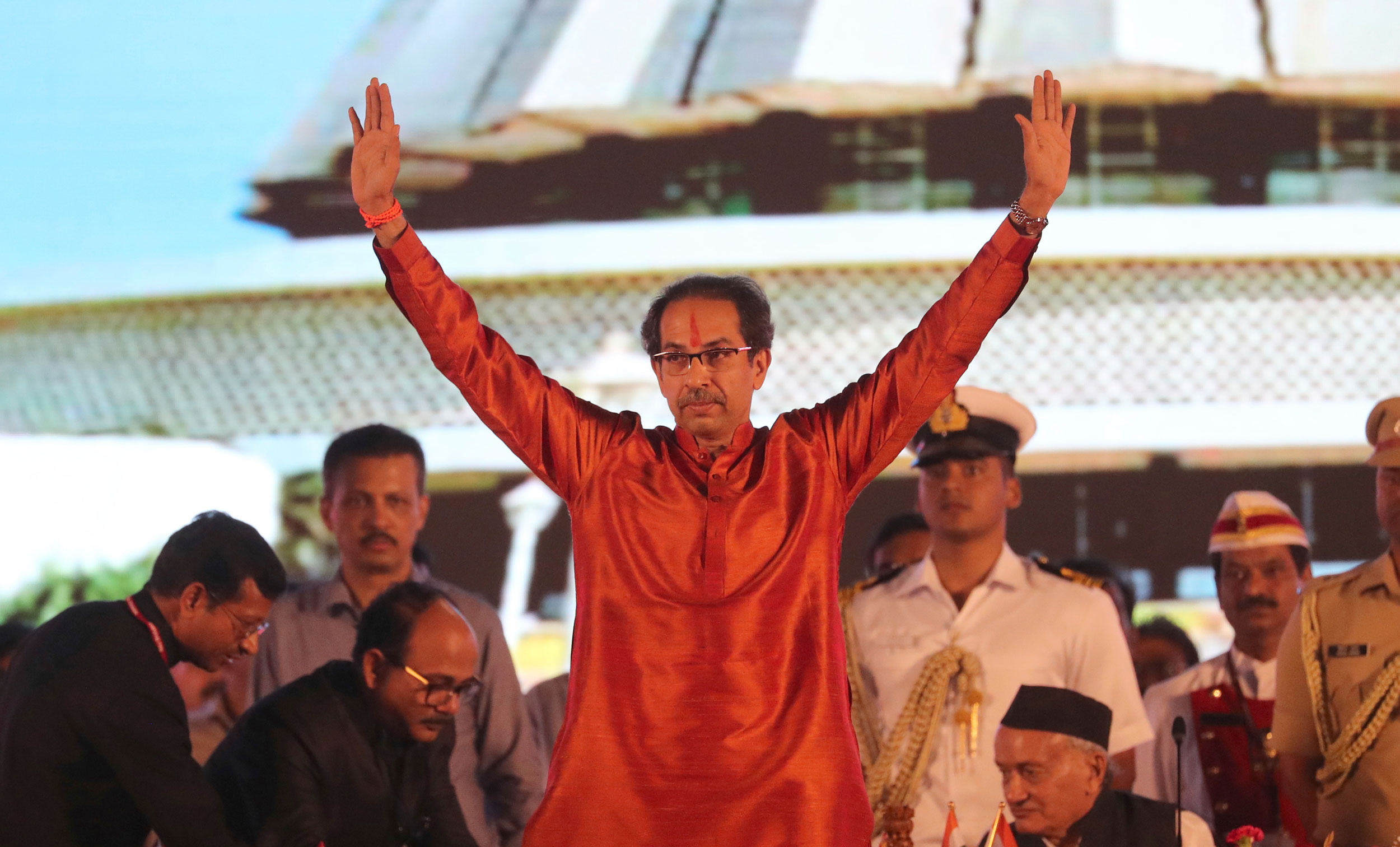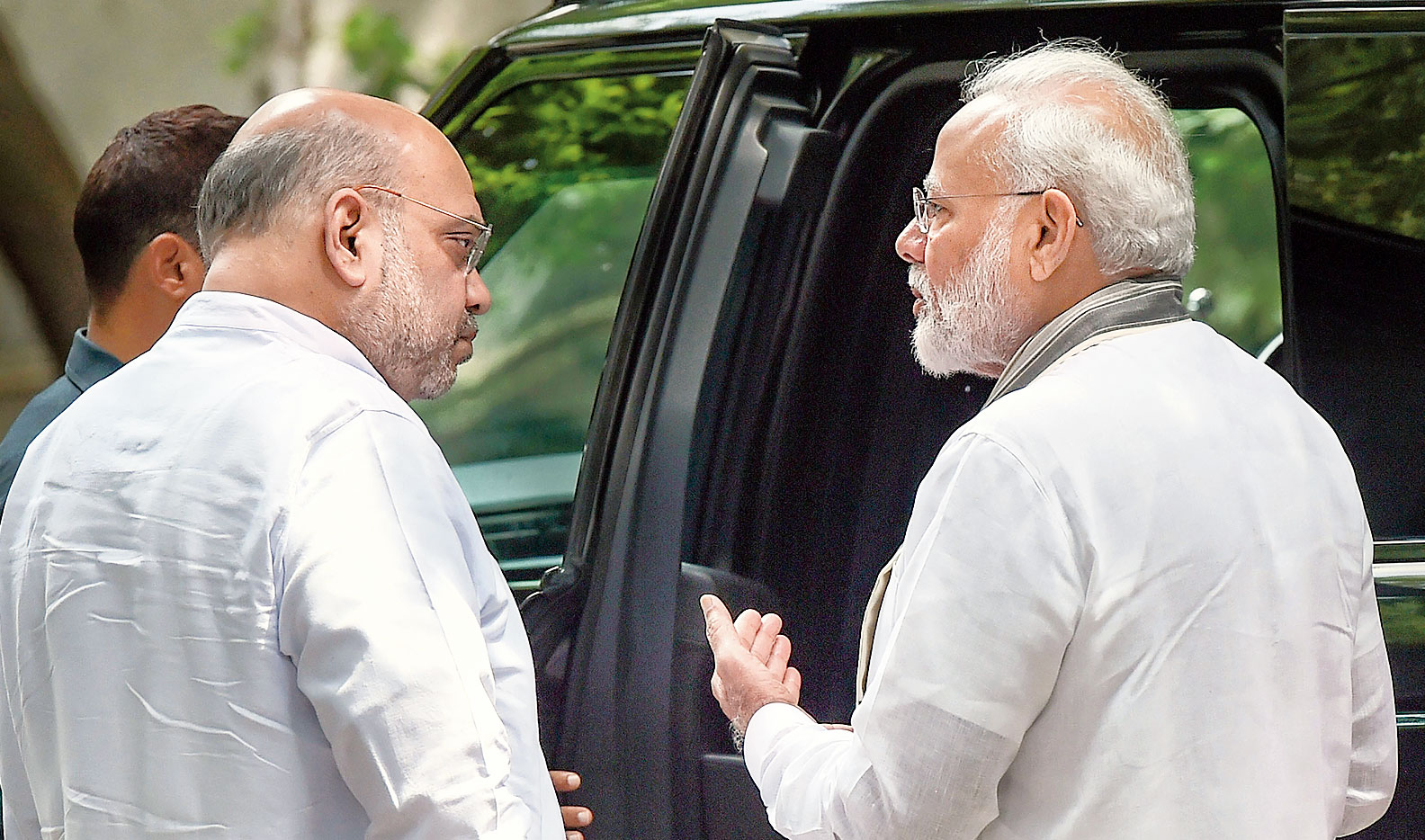For the BJP’s foot-soldiers Prime Minister Narendra Modi and home minister Amit Shah have always been like Napoleon’s ‘lucky generals’ who would snatch victory against all odds. That confidence has been dented after the month-long political drama in Maharashtra, the first act of which ended on Saturday with the vote of confidence in the state assembly. “The perception had been assiduously created that whatever the election result, the government would be BJP,” says Congress MP Manish Tewari.
Now, the party’s facing a new reality after a string of unexpected defeats. Uddhav Thackeray’s been sworn in as Maharashtra chief minister and sailed through Saturday’s floor test; in Bengal, Mamata Banerjee’s Trinamul has won back what were strong BJP seats only six months ago.
In Haryana, the BJP’s in an uneasy alliance with political novice Dushyant Chautala and his newly formed Jannayak Janta Party (JJP). The harsh truth has been driven home to the BJP that it can’t dictate terms. For instance, in Haryana, it took two weeks to name cabinet ministers and the government’s still in low-gear because the two parties have just begun intense negotiations to hammer out a common minimum programme. Says Tewari: “It puts a comma on the hubris. I hope over a period of time, the comma becomes a full-stop.”
Look to the political horizon, too, and the longer-term view’s begun to shift. After Modi’s May sweep, political observers became convinced the BJP would be the party of government for the foreseeable future. Now that assumption may be more in doubt.
The next general elections are more than four years away but let’s ask the question now: Can the BJP win a general election unless it does well in Maharashtra? The state sends 48 MPs to Parliament, second only to Uttar Pradesh's 80. In the 2019 general elections, the BJP won 23 seats in Maharashtra and its ally, the Shiv Sena won 18, making a grand total of 41 seats out of the state’s 48. Fast-forward to 2024: how many seats might the BJP win if it was fighting a ‘Maratha Pride’ coalition of the Shiv Sena and the Sharad Pawar-led NCP? It’s a safe bet the BJP wouldn’t get 23.

Shiv Sena chief Uddhav Thackeray greets the crowd after after taking oath as the chief minister of Maharashtra during the swearing-in-ceremony in Mumbai on Thursday. (AP)
The defeats have been all the more devastating for the BJP because the party was convinced both Maharashtra and Haryana would be walkovers. In Haryana, political pundits were confident the BJP would leave its opponents in the dust and low-profile chief minister Manohar Lal Khattar was hailed as a political star. After all, the BJP had won all 10 Lok Sabha seats in May by huge majorities. It faced a credible challenge then only in Rohtak but still managed to brush past the Congress Party’s Deepender Singh Hooda by 7,500 votes.
The BJP insists that too much is being made of the state-level losses. Party spokesman Nalin Kohli points out that in Maharashtra the party won 105 seats and that it wasn’t able to form a government because its alliance partner walked out on it. About the other states he says that in Madhya Pradesh the difference between the BJP and the Congress was wafer-thin. “Madhya Pradesh was almost a BJP win. Around 3,400 votes was the difference between us and the government.”
Kohli insists that too much should not be read into the other state-level losses too. He says: “Even Rajasthan is not a clear mandate for the Congress.” In Bengal he blames Trinamul strongarm tactics. And, he says that Haryana has a track record of throwing out the ruling party after five years and that only the Hooda government was able to counter that. But he admits the party suffered a clear defeat in Chhattisgarh. “The state went conclusively against us. But that’s after we ruled there for 15 years.”
Could it be simply that people vote differently in general and state-level elections which is often the case in federal systems? After all, last December, the BJP lost Madhya Pradesh, Rajasthan and Chhattisgarh. In May, when the general elections came around, the party won overwhelming victories in all three states. Now, the same phenomenon has occurred in Haryana, Maharashtra and three by-elections in Bengal.
Or, is it another scenario in which voters want and vote for Modi at the Centre but are more likely to go with a local chieftain like Sharad Pawar or Mamata Banerjee in state elections? Elections are on in Jharkhand and due soon in Delhi. In Delhi, the predictions are that Arvind Kejriwal’s Aam Aadmi Party will defeat the BJP. Kohli says the party does depend heavily on the Narendra Modi factor. “The state is not a referendum on Modi. We won wherever he held a rally. But we can’t have him for every rally.”

Mamata Banerjee in Calcutta on November 22, 2019. (AP)
Another way of looking at it could be that the BJP wilts whenever it faces tough opposition. “In any election in which the BJP has credible opposition, they will lose, they can only win in a political vacuum where there’s no real opposition,” says a political observer who doesn’t believe in Modi’s invincibility.
Certainly, after the Maharashtra debacle for the BJP, state-level chieftains around the country have emerged looking stronger and taller. Amarinder Singh led the Congress to victory in Punjab. In Haryana most observers say the Congress made up lost ground only when former chief minister Bhupinder Singh Hooda took charge of the campaign. Similarly, in Bengal Mamata has cleaned up the Trinamul Congress’ act and seems to have regained ground after the shock losses at the general election. And, above all others, in Maharashtra, the Man of the Match is clearly Sharad Pawar who overcame every obstacle thrown in his way.
The BJP’s imbroglio isn’t helped by the fact it’s been stumbling badly in its second term. Its supposed forte -- the economy --_is tanking. More on that later. Kashmir’s been in a semi-shutdown for almost 120 days. The government is stonewalling and insists the state’s mostly back to normal but critics challenge that. In Assam too, it’s faced unrest, though not of its own making. The NRC is still causing ripples throughout the northeast and now looks like it was a factor in the West Bengal by-elections. Shah has talked about extending it across the country but that would be a massively costly and divisive exercise and looks unlikely.
The election defeats and the moves in Kashmir have turned the spotlight on BJP strongman Shah who the party’s attempted to project as India’s new Iron Man, the Gujarati Sardar Vallabhai Patel of this generation. But has Shah really displayed the administrative genius needed? Again, it's early in the party's second term, but he’s putting himself in a position where he’ll be catching the flak for the government’s bungles.
On the economy, the government's biggest fire-fighting challenge, it looks to be floundering on how to fix it. Data on Friday showed second-quarter GDP growth at a six-year low of 4.5 per cent. Nearly every industry from automobiles, to housing, telecom, steel and cement are struggling. Most alarmingly, the collapse of IL&FS has left companies with fewer places to get loans and eroded faith in banking system.
In addition, both GST and tax collections are way below target, leaving the government struggling to plug its revenue shortfall. The government’s also set itself an impossibly tight schedule to sell off large, high-profile companies like BPCL and Air India by March 31 so proceeds can be used to make up this year’s budget shortfall.
Now in its latest effort to boost the economy, the government would like to lower GST rates but to do that it needs all states to give the thumbs-up and their take has already fallen badly under the new tax collection system. While late finance minister Arun Jaitley was an experienced negotiator, his successor, Nirmala Sitharaman, is a rookie in the finance job. So, this task might be far tougher.
The government is insisting the slowdown is just temporary. But many economists say the economy's still suffering from the double-whammy of Modi’s demonetisation and the badly structured GST introduced a year later.
The Congress’s Manish Tewari believes there’s a simple reason behind the government’s missteps. He points to its grandiose plan to rebuild Lutyens’ Delhi and says: “You become victim of a serious disease called delusionitis.” He adds: “It’s the classic man and the manhole syndrome. When you walk with your eyes fixed on the sky, you fall into a manhole.” The BJP needs to start focusing on the ground again if it wants to stop events going even more haywire for them.











